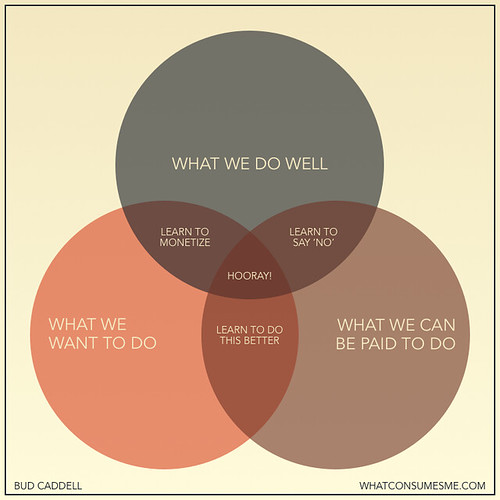Forget the money for a second. They’re all broke, just divorced or downsized, moved back in with Mom and Dad. But you get up each morning looking forward to seeing them, talking to them, spending time with them.
Oh, and selling them stuff. Stuff that you know they’re going to totally dig, because you totally dig it. And they love you right back for selling it to them.
Who wants to be that guy?
But you’re not. “That guy” — the sleazeball that’s always pimping the latest multi-level marketing crap at parties — doesn’t really love his customers. He loves their money.
You love them for what they are. You’re one of them. Except that you’re good at something most of them aren’t. Maybe you write music. Or you’re a painter. Or you’re just really good at finding great new restaurants. So you do it for them.
“Do what you love … yadda yadda … heard it all before.”
Close, but not quite. Maybe you heard it from Brian Clark:
Do what you love and don’t worry about the consequences.
Or you saw the Venn diagram everyone uses to tell you what to do with your life:

But maybe you also heard that you have to always put the reader first. To start from what your customers need and give it to them.
But all of this advice is missing something important.
Who are your customers?
Who do you want to spend your day with?
If you love building and painting choppers, you’ll probably spend lots of time with bikers. You like grooming Pomeranians? You’ll be with little old ladies and gay men.
Is that who you want to spend your day with? Every day?
Because once you’ve picked your niche, once you’ve picked who you’re going to follow, that’s who you’re going to spend your working life with.
Pick them on purpose
Contrary to every other piece of advice I’ve seen on this, I’m telling you to pick your customers first. Don’t start from your interests and look for a market. And definitely don’t pick a market just because it’s a market.
Look for people you like. People you’re willing to spend time with. Lots of time. Too much time.
If you don’t love spending time with these people, it’ll show. You may get by for a while, finding the intersection between what they want and what you want to give.
But if you love them, you’ll be willing to follow them where they want to go.



